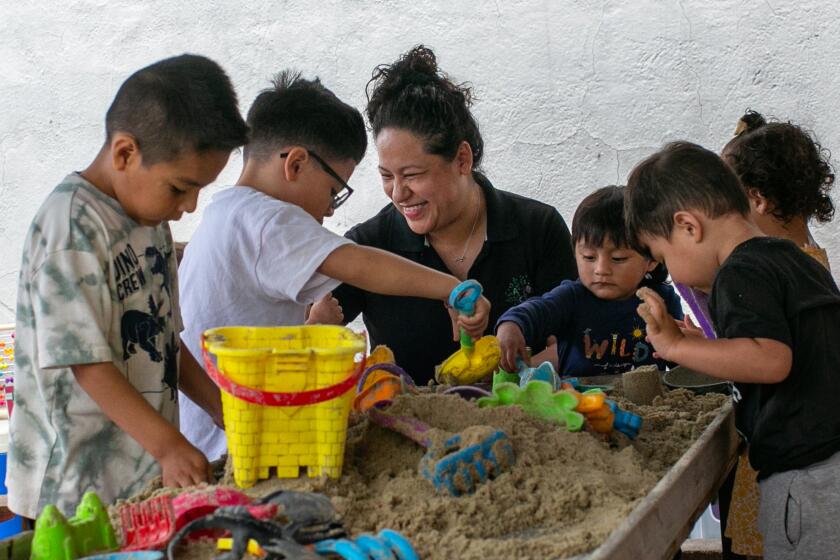A payment overhaul is coming to California child care, along with a 20% raise for workers

- Share via
More than 40,000 California child-care providers who watch the children of low-income workers have secured a 20% average pay increase under a tentative union agreement with the state — a “watershed moment” for an industry dominated by immigrant women of color, labor officials and experts said.
In addition to the $600 million to fund the rate increase over two years, the new contract for provides $80 million to create the nation’s first retirement fund for child-care providers, and $100 million for healthcare funding. Less than a quarter of family child-care providers reported any retirement savings, according to research from the Center for the Study of Child Care Employment at UC Berkeley.
And in a key contract win for Child Care Provider’s United union members, the state has agreed to a timeline to overhaul the way rates are calculated for providers who receive subsidies to care for the children of low-income families. Currently, voucher rates are based on a 2016 market survey of the prices families pay for care in each region. But since actual child-care costs are more than most parents can afford, the subsidies do not come close to covering all of the expenses for high-quality care, according to a report from California’s Rate and Quality Workgroup.
A new rate structure paying providers the “true cost of care” could take effect as early as 2025, said Max Arias, the union’s chief negotiator. “That to me is the biggest win. Of course we have to continue to work with the state and push elected officials to stay with it, but it’s a clear commitment in our contract that’s enforceable.”
As child-care workers struggle to pay bills, in-home providers push for higher wages and urge the state to overhaul rates for its subsidized care program.
The size of the contract’s investment makes the tentative deal a “watershed moment” in California, and an important step toward worker equity, said Brandy Jones Lawrence, a senior analyst at the UC Berkeley center. “It’s a huge win that they got such a big boost to payment when the state could have kicked it down the road a little longer.”
The contract’s temporary 20% average rate increase, which would vary slightly by region and would expire after two years, is intended to provide enough cash to keep providers afloat until then. Many family child-care providers currently earn less than minimum wage and are barely scraping by, Arias said.
Arias believes it will be enough to stop providers from leaving the industry, which has sent families scrambling to find available child care, especially for infants and toddlers. About 12% of licensed child-care capacity in California closed permanently during the pandemic, with new growth lagging behind, according to California Department of Social Services data cited in a recent Assembly hearing.
“Here in California, we continue to invest in our early learning workforce,” said Kim Johnson, director of the state Department of Social Services. “It’s critical that working families across California have equitable access to quality, reliable child care and development services that keep families earning and children learning.”
The contract next goes to a union vote and must be approved by the Legislature and signed by Gov. Gavin Newsom, actions expected this summer.
The deal does not quite reach the 25% raise proposed by the Assembly to track with inflation since rates were last calculated. Neither the contract’s rate increase nor healthcare and retirement funds are permanent; they would expire at the end of the contract.
“The only reason we accepted this is because we got the cost-of-care timeline,” said Arias, who added that the union would otherwise have demanded a permanent percentage increase to the voucher rates. “Sometimes you have to make decisions based on where you are.”
As California expands access to transitional kindergarten for all 4-year-olds, districts across the state struggle to recruit and accommodate young learners.
Adriana Lorenzo, who runs a home day-care center with 14 children in Boyle Heights, traveled to Sacramento to take part in the union negotiations and actions, which included a rally and a candlelight vigil at the governor’s mansion. Although she doesn’t yet know exactly how much more money she will receive, she said she’s “super excited” about the tentative contract agreement.
After covering all her business expenses, including electricity, supplies, rent, food and the salary of a full-time aide, Lorenzo’s child-care operation currently brings in about $1,000 per month. She thought about closing several times during the pandemic, when inflation sent prices soaring. Instead, she and her husband started delivering food and packages for Amazon Flex, working the midnight shift after all of the children had gone home for the evening.
She hopes the rate increases will help make her business more viable in the long term. “We’re praying we will be able to drop the deliveries to focus more time on school and the kids,” she said.
Zoila Carolina Toma, who operates an in-home program in Lakewood, said the rate increase would allow her to raise wages for her employees from $16.50 an hour to at least $18. Still, she said she’s planning to close her day-care program within the next five years, after she finishes her bachelor’s degree.
“This business is beautiful, but at the same time, I cannot call and say, ‘I’m not feeling well today.’ My doorbell is going to ring regardless,” she said. “There’s a lot of compromises we make in this industry.”
Funding for the contract’s rate increase and other programs was secured as part of a two-year, $2.8-billion boost to child-care programs in the recent budget agreement.
The budget also brought relief for many low-income families by capping the amount of money they must contribute toward child-care payments at 1% of monthly income. Some families were previously paying up to 10% of their income in co-payments toward the state’s child-care subsidies. All family fees were paused during the pandemic and had been scheduled to restart on Oct. 1.
This article is part of The Times’ early childhood education initiative, focusing on the learning and development of California children, from birth to age 5. For more information about the initiative and its philanthropic funders, go to latimes.com/earlyed.
More to Read
Sign up for Essential California
The most important California stories and recommendations in your inbox every morning.
You may occasionally receive promotional content from the Los Angeles Times.













